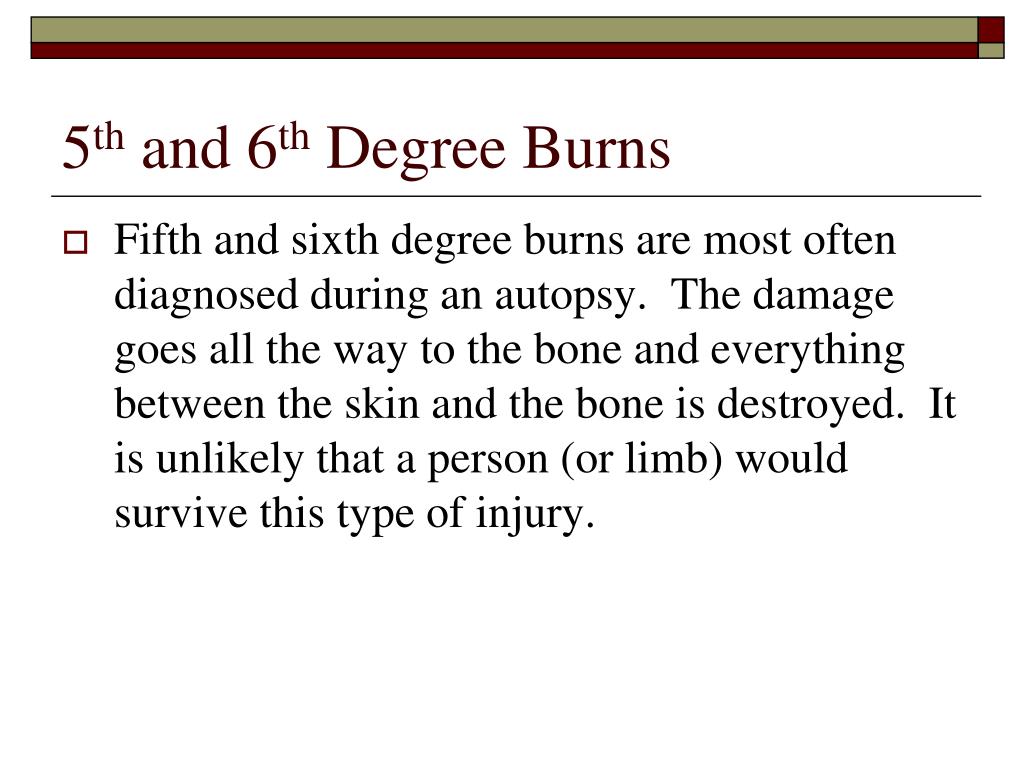
If death does not occur, amputation will be required. If the fatality was caused by another person’s negligence, the burn victim’s family is entitled to bring a wrongful death claim against the wrongdoer. Sixth-degree burn injuries occur when heat destroys the muscles, charring and exposing the bone. Permanent and prominent scarring with loss of keratin in the area of the burn will occur.
#6TH DEGREE BURN SKIN#
If amputation is not needed, skin grafting will be required.

Fifth-degree burn injuries also may require amputation due to damage to muscles.

These burns can be fatal due to damage to major arteries and veins. Skin grafting is required and permanent motor damage may occur.įifth-degree burn injuries occur when all the skin and subcutaneous tissues are destroyed, exposing muscle. Like third-degree burns, fourth-degree burns result in scarring and loss of keratin - loss of hair shafts and fingernails (if the burn is on the hand) and toenails (if the burn is on the feet). These burns are not painful because all the nerves have been damaged and are not sending pain signals however, all third-degree burns are surrounded by first and second-degree burns which are painful.įourth-degree burn injuries occur when heat damage destroys the dermis and muscle tissue is affected. Third-degree burns result in scarring, the loss of keratin (a fibrous insoluble protein that is the main structural element in hair and fingernails) - a loss of hair and a loss of fingernails if the burn is on the hand and loss of toenails if the burn is on the feet. Charring and extreme damage of the epidermis, and sometimes hard eschar (necrotic tissue - a dry scab formed on the skin - in the process of separating) will be present. They are often caused by scald (immersion), may involve flame, steam, oil, grease, chemicals, or high-voltage electricity. Third-degree burn injuries occur when the epidermis is lost with damage to the subcutaneous tissue (the layer of loose connective tissue directly under the skin). Third-Degree Burn a/k/a Full-Thickness Burn Deep dermal burns usually take more than three weeks to heal and should be treated by a surgeon, as those burns often must be excised and skin grafted for best results. Your dermis contains the hair follicles, sweat glands, oil glands, lymphatic vessels and blood vessels. These nerve endings work with your brain and nervous system and allow you to feel things and react to them - provides the sense of touch and heat. You will find your nerve endings in this layer of skin. It is tightly connected to the epidermis by a basement membrane. The dermis consists of connective tissue and cushions the body from stress and strain. Second-degree burn injuries involve the superficial dermis (the layer of skin adjacent to the epidermis called the papillae region) and may also involve the deep dermis layer (thicker area under the papillae region known as the reticular region). These burns may or may not cause scarring, but often do cause long-term skin color changes.

They are often caused by a scald (spill or splash) or short (“flash”) flame exposure. Second-degree burn injuries are seen as redness and blistering of the skin and can involve more or less pain depending on the level of nerve involvement. Second-Degree Burn a/k/a Superficial Partial-ThicknessĪnd Sometimes Deep Partial-Thickness Burn The epidermis layer is constantly making new skin, as well as a substance called melanin which gives your skin its color. It is composed of dead skin cells that were made at the bottom of this layer and have risen to the top. It forms the waterproof, protective wrap over the body’s surface. These burns involve the epidermis which is the layer of skin you see - the outermost layer of skin. They usually take between 3 - 6 days to heal. First-degree burns are often caused by ultraviolet light or very short (“flash”) flame exposure. The area may swell, but it is dry and there is no blistering. The area blanches (turns white) when you press on it. A description of the traditional and current classifications are as follows:įirst-degree burns only involve the epidermis and usually do not cause scarring.
#6TH DEGREE BURN FULL#
A more recent classification is superficial thickness partial thickness and full thickness. VIRGINIA FIRE ACCIDENT ATTORNEY FIGHTING FOR BURN VICTIMS INīurn injuries are classified as first-degree second-degree third-degree fourth degree fifth-degree and sixth-degree.


 0 kommentar(er)
0 kommentar(er)
